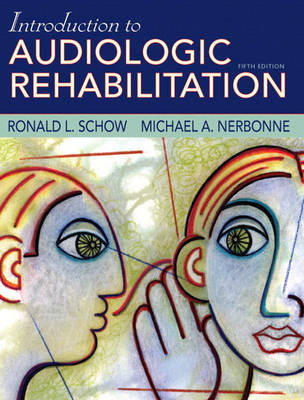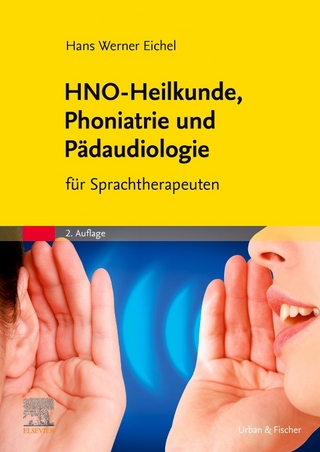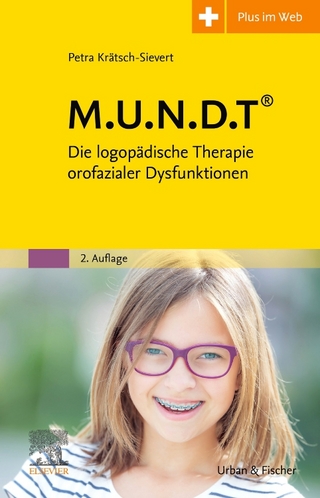
Introduction to Audiologic Rehabilitation
Pearson (Verlag)
978-0-205-48292-4 (ISBN)
- Titel erscheint in neuer Auflage
- Artikel merken
This highly regarded text has been substantially updated and revised, making it more user-friendly for both students and instructors. It is especially current in areas dealing with hearing aids, cochlear implants, and current approaches to providing relevant AR. The text begins with eight chapters introducing the fundamentals–amplification, including cochlear implants, auditory and visual stimuli, speech and language, and educational and psychosocial issues. Two comprehensive methods and procedures chapters follow, focusing on children, adults, and elderly adults. Finally, the well-documented and amply illustrated text concludes with two case study chapters.
The Fifth Edition includes substantial new content related to hearing aids, cochlear implants, and relevant forms of AR. Information on vestibular and tinnitus assessment and management has been greatly expanded. Additional case studies throughout the text help emphasize key points and allow students applicable practice of the concepts learned in a hands-on manner. Recommended websites and readings at the end of each chapter guide students to an abundance of relevant, supplemental AR material.
Two complete case study chapters (adult and children) with added case examples.
Each chapter begins with “Introduction” and concludes with “Summary Points,” “Recommended Reading,” “Recommended Websites,” and “References.”
I. FUNDAMENTALS OF AUDIOLOGIC REHABILITATION.
1. Overview of Audiologic Rehabilitation.
Ronald L. Schow & Michael A. Nerbonne
Definitions and Synonyms
Providers of Audiologic Rehabilitation
Education Needs of Providers
Hearing Loss Characteristics
Degree of Hearing Impairment and Configuration
Time of Onset
Type of Loss
Auditory Speech Recognition Ability
Consequences of Hearing Loss: Primary and Secondary
Communication Difficulties
Variable Hearing Disability
Rehabilitative Alternatives
Historical Background
Birth of Audiology
Difficulties in Acceptance of Audiologic Rehabilitation
Current Status
Procedures in Audiologic Rehabilitation: An AR Model
Rehabilitation Assessment Procedures
Management Procedures
Settings for Audiologic Rehabilitation
Children
Adults
Elderly Adults
2. Hearing Aids and Assistive Devices.
H. Gustav Mueller, Earl E. Johnson & Anne S. Carter
Introduction
Hearing Aids
Basic Components
Controls and Features
Hearing Aid Styles
The Body Aid
The Eyeglass Aid
The BTE
The ITE
The ITC
The CIC
Summary
Specialized Filling Options
CROS and BICROS
Bone Conduction and Implantable Hearing Aids
Traditional Bone Conduction Devices
Implantable Hearing Aids
The Earmold
Acoustic Effects of Earmolds
Low-frequency Modification
Mid-frequency Modification
High-frequency Modification
The Earmold Impression
Batteries
Electroacoustic Properties
The Selection and Filling of Hearing Aids
Step 1: Selecting the Hearing Aid Candidate
Degree of Hearing Loss
Degree of Communication Disability
Motivation to Use Hearing Aids
Step 2: Preselection Measurements
Pure Tone Thresholds
Loudness Discomfort Level (LDL)
Loudness Contour Testing
Step 3: Hearing Aid Selection
Hearing Aid Style
Gain and Frequency Response
Maximum Output
Automatic Signal Processing (ASP)
Programmable Hearing Aids
Digital Signal Processing
Binaural Fittings
Other Considerations
Step 4: Verification
Informal Rating of Speech Quality and Intelligibility
Speech Recognition or Intelligibility Testing
Loudness Scaling
Probe Microphone Measurements
Step 5: Postfitting Counseling, Orientation, and Outcome Measures
Postfitting Counseling and Instrument Orientation
Follow-up Visits and Outcome Measures
Considerations for the Pediatric Patient
Prefitting Testing
Fitting Considerations
Verification of Fitting
Postfitting Procedures
Assistive Listening Devices and Other Communicative Devices
Alerting/Signaling Devices
Concluding Summary Points
3. Cochlear Implants and Vestibular/Tinnitus Management.
Alice E. Holmes & Gary P. Rodriguez
How Does a Cochlear Implant Work?
History of Cochlear Implants
The Cochlear Implant Team
Who Is a Candidate?
Candidacy for Adults
Candidacy for Children
Deaf Culture and Cochlear implants
Treatment Plans for Cochlear Implant Recipients
Hook-up
Follow-up Programming and Therapy
Variables Affecting Performance
Future Trends in Cochlear Implants
Auditory Brainstem Implant
Vestibular Rehabilitation
Tinnitus Management
4. Auditory Stimuli in Communication.
Michael A. Nerbonne & Ronald L. Schow
A Communication Model
Auditory Perception
Development of Auditory Skills
Basic Perception Abilities
Acoustics of Speech
Intensity Parameters of Speech
Frequency Parameters of Speech
Temporal Parameters of Speech
Transitional Cues
Speech Perception and Comprehension
Speech Perception and Hearing Loss
Physical Properties
Redundancy and Noise
The Auditory Training Process
Definition and Application of Auditory Training
Early Efforts in Auditory Training
Carhart
Current Approaches to Auditory Training
Candidacy for Auditory Training
Assessment of Auditory Skills
Evaluating Children
Evaluating Adults
Methods of Auditory Training
Erber
DASLII
SKI-HI
SPICE
Consonant Recognition Training
Communication Training and Therapy
5. Visual Stimuli in Communication.
Nicholas M. Hipskind
Factors Related to Speechreading
Speaker
Signal and Code
Visemes
Visibility
Environment
Speechreader
Age
Gender
Intelligence
Personality Traits
VisualSlcills
VisualAcuity
Visual Perception
Hearing
Speechreading and the Hearing impaired
Assessment of Speechreading Ability
Formal Speechreading Tests
Informal Speechreading Tests
Visual Assessment and Speechreading Evaluation
Hearing Impairment and Dependence on Vision
Deaf
Hard of Hearing
Traditional Speechreading Methods
Analytic and Synthetic Approaches
Recent Trends in Speechreading Instruction
Children
Adults
Innovative Options
Manual Communication
Types of Manual Communication
Signed English Systems
Fingerspelling
Cued Speech
Appendixes
6. Language and Speech of the Deaf and Hard of Hearing.
Deborah S. Culbertson
Introduction
Language and Communication
Factors Affecting Language Acquisition
Language Characteristics of Preschool Children with Hearing Impairment
Importance of Parent-Child Interactions
Knowledge of Schema in Preschool Children
Semantic and Pragmatic Functions in Preschool Children
Early Vocabulary in Preschool Children
Language Characteristics of School-Age Children with Hearing Impairment
Lexical-Semantic Skills of School-age Children
Syntactic-Morphologic Skills of School-age Children
Pragmatic Skills of School-age Children
Plateau in Language Acquisition for School-age Children
Preliteracy and Literacy Issues
Language Assessment
Limitations and Cautions in Using Formal Language Measures
Essential Conditions for Evaluating Language Abilities
Communication and Language Management for Preschool and School-Age Children with Hearing Impairment
Strategies for Developing Conversational Skills
Preliteracy and Literacy Activities
Bilingual Education for Children Who Are Deaf
Speech Characteristics, Assessment, and Management
Hearing as the Foundation for Speech Sound Development
Early Vocalizations of the Child
Speech Intelligibility
Speech Characteristics, Assessment, and Management for individuals with Prelingual Hearing Loss
Individuals with Mild to Moderately Severe Prelingual Hearing Loss
Individuals with Prelingual Hearing Loss in the Severe to Profound Range
Speech Assessment of Individuals with Severe or Profound Hearing Loss
Measures of Speech Intelligibility
Measures of Articulation and Phonology
Perceptual Assessment of Suprasegmentals and Voice Characteristics
Acoustic and Physiologic Displays
Speech Management for Individuals with Severe or Profound Hearing Loss
Speech Characteristics of Individuals with Postlingual Profound Hearing Loss
7. Psychosocial Aspects of Hearing Impairment and Counseling Basics.
Kris English
Psychosocial Aspects of Hearing Impairment
Growing Up with Hearing Loss
Self concept
Emotional Development
Family Concerns
Social Competence
Special Issues in Adolescence
Summary
Acquiring Hearing Loss
Selfconcept
Psychoemotional Reactions
Family Concerns
Social Concerns
Summary
About Being Deaf
Being Deafened
"Deafness with a Capital D"
"Knowing Is Not Enough": Counseling Basics
Important Distinctions
What We May Think Counseling Is
What Counselors Say Counseling Is
The Counseling Process
Help Patients (or Parents) Tell Their Story
Help Patients Clarify Their Problems
Help Patients Take Responsibility for Their Listening Problems
When to Refer
8. Audiologic Rehabilitation Services in the School Setting.
Kris English
Why AR Services Are Required in School Settings: The Educational Consequences of Hearing Impairment
Degree of Loss: Terminology
Mandated by Law
Key Components of IDEA
Least Restrictive Environment
Educational Options
LRE for a Child with HI
The Individualized Education Program
The Communication Debate
Oral-Aural Approach
Total Communication
Cued Speech
Using Sign Only
AR Services Provided in Schools
Screening and Assessment
Management of Amplification
Direct Instruction and Indirect Consultation
Hearing Conservation
Evaluation and Modification of Classroom Acoustics
Transition Planning to Postsecondary Placements
How Services Are Provided
AR Service Providers in School Settings
Teachers
Audiologists
Speech-Language Pathologists
Related Support Personnel
Services for Children with Auditory Processing Problems
II. COMPREHENSIVE APPROACHES TO AUDIOLOGIC REHABILITATION.
9. Audiologic Rehabilitation for Children: Assessment and Management.
Mary Pat Moeller , Ronald L. Schow & Mary M. Whitaker
Prevalence of Loss and Level of Service
Terms and Definitions
Profile of the Client
Hearing Loss
Age
Other Disabling Conditions
Rehabilitation Settings and Providers
Identification and Assessment Procedures with Children
Early Identification
School Screening
Medical and Audiologic Assessment
Aspects of Audiologic Rehabilitation: Early Intervention for Parent-Infant and Preschool
Rehabilitation Assessment
Management
Environmental Coordination and Participation
Audibility, Amplification, and Assistive Device Issues
Remediation of Communication Rehabilitation Activity
Counseling and Psychosocial Aspects
Aspects of Audiologic Rehabilitation: School Years
Rehabilitation Assessment: IEP Meeting
Management
Environmental Coordination and Participation
Audibility, Amplification, and Assistive Device Issues
Communication and Language Stimulation: School-age Level
Counseling and Psychosocial Aspects (Special Case)
Appendix
10. Audiologic Rehabilitation for Adults and Elderly Adults: Assessment and Management.
Kathy Pichora-Fuller & Ronald L. Schow
Profile of the Adult Client
Hearing Loss over the Life-span
Profile of the Elderly Client
Hearing Loss
Physical and Mental Health and the Aging Process
Personal and Environmental Factors
Economic Status and Retirement
Living Environments
Model for Rehabilitation
CORE Assessment
Care Management
Rehabilitation Settings
University Programs
Community Centers and Agencies
Military
Consumer Groups
Hospitals, Medical Offices, Private Practice Audiologists, and Hearing Instrument Specialists
Rehabilitation Assessment
Assessing Impairment
Assessing Activity and Participation
Case History
Self-report
Outcome Measures
CORE Assessment Summary
Rehabilitation Management
Counseling and Psychosocial Considerations
Amplification and Instrumental Interventions to Achieve Audibility
Is the Client Ready for an Instrument?
Fit and Function of the Instrument
Counseling and Orientation to Instruments
Remediation for Communication Activities
Environmental Coordination and Participation Improvement
Further Illustration of CORE and CARE
III. IMPLEMENTING AUDIOLOGIC REHABILITATION CASE STUDIES.
11. Case Studies: Children.
Mary Pat Moeller
Case 1 Joey: Family-centered Intervention: Multiple Disabilities
Background Information
Previous Rehabilitation
Environmental Coordination and Participation
Communication Rehabilitation Adjustment
Psychosocial and Counseling Aspects
Case 2 Mike: Decision Making by a Student Related to Cochlear Implants
Background Information
Aural Rehabilitation Plan: Pre-implant
Aural Rehabilitation Plan: Post-implant
Intervention Outcomes
Summary
Case 3 Amber: Issues Affecting Educational Placement
Background Information
Assessment Findings
Recommendations for Management
Follow-up Assessment
Case 4 Greg: Late Identification of a Hard-of-Hearing Child
Background information
Communication Activity Assessment
Management
Remediation of Communication Activity: Auditory and Linguistic Training
Intervention Outcomes
Summary
Case 5 Sam: Differential Diagnosis through Professional Teamwork: A Tool for Solving Complex Intervention
Background Information
Educational/Rehabilitative History
Psychological and Communication Findings
Functional Auditory and Speech Production Skills
Diagnostic Teaching
Putting it all together
12. Case Studies: Adults and Elderly Adults.
Michael A. Nerbonne, Jeff E. Brockett & Alice E. Holmes
Case 1 Dr. M.: Progressive Hearing Loss
Case History
Audiologic Rehabilitation Assessment
Management
Hearing Aid Evaluation and Adjustment
Communication Training
Summary
Case 2 Mr. B.: Hearing Loss, Depression, and Successful Hearing Aid Use
Informational Counseling
Rehabilitation Assessment
Communication Status: Impairment Activity Limitations
Overall Participation Variables
Related Personal Factors
Environmental Factors
Rehabilitation Management
Counseling and Psychosocial Issues
Audibility and Impairment Management
Remediaie Communication Activity
Environment and Coordination: Participation Improvement
Summary
Case 3 JD: AR featuring a significant Other
Introduction
Informational Counseling
Rehabilitation Assessment
Rehabilitation Management
Summary
Case 4 Mrs. D.: Cochlear Implant User
Case History
Assessment Information
Pre-CI Management
Counseling and Psychosocial Considerations
Communication Remediation
CI Surgery
Post-Cl Management
Audibility and Amplification
Audiovisual Training for Communication
Counseling and Coordination
Summary
Case 5 Mrs. E.: Nursing Home Hearing Aid User
Case History
Diagnostic Information
Audiologic Rehabilitation
Author Index
Subject Index.
| Erscheint lt. Verlag | 25.10.2006 |
|---|---|
| Sprache | englisch |
| Maße | 239 x 196 mm |
| Gewicht | 976 g |
| Themenwelt | Medizin / Pharmazie ► Gesundheitsfachberufe ► Logopädie |
| Medizin / Pharmazie ► Medizinische Fachgebiete ► HNO-Heilkunde | |
| Medizin / Pharmazie ► Physiotherapie / Ergotherapie ► Rehabilitation | |
| ISBN-10 | 0-205-48292-9 / 0205482929 |
| ISBN-13 | 978-0-205-48292-4 / 9780205482924 |
| Zustand | Neuware |
| Haben Sie eine Frage zum Produkt? |
aus dem Bereich



